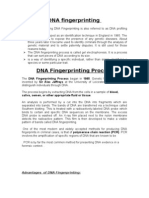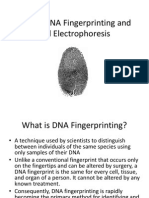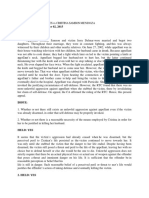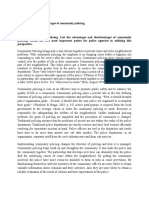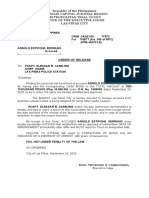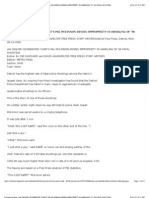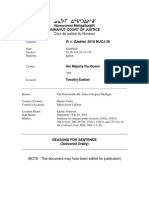0 ratings0% found this document useful (0 votes)
560 viewsDna
Dna
Uploaded by
neerja poddarThe document provides an overview of DNA fingerprinting, including:
1) It describes the history and invention of DNA fingerprinting by Alec Jeffreys in 1984.
2) It explains the basic process of DNA fingerprinting, which involves extracting DNA from samples, cutting the DNA into fragments, separating the fragments by size, and analyzing the pattern to identify individuals.
3) It discusses some common applications of DNA fingerprinting such as establishing paternity, identifying criminals, solving missing persons cases, and resolving disputes.
Copyright:
© All Rights Reserved
Available Formats
Download as PPTX, PDF, TXT or read online from Scribd
Dna
Dna
Uploaded by
neerja poddar0 ratings0% found this document useful (0 votes)
560 views16 pagesThe document provides an overview of DNA fingerprinting, including:
1) It describes the history and invention of DNA fingerprinting by Alec Jeffreys in 1984.
2) It explains the basic process of DNA fingerprinting, which involves extracting DNA from samples, cutting the DNA into fragments, separating the fragments by size, and analyzing the pattern to identify individuals.
3) It discusses some common applications of DNA fingerprinting such as establishing paternity, identifying criminals, solving missing persons cases, and resolving disputes.
Original Description:
This ppt is about dna fingerprinting
Original Title
dna(1)
Copyright
© © All Rights Reserved
Available Formats
PPTX, PDF, TXT or read online from Scribd
Share this document
Did you find this document useful?
Is this content inappropriate?
The document provides an overview of DNA fingerprinting, including:
1) It describes the history and invention of DNA fingerprinting by Alec Jeffreys in 1984.
2) It explains the basic process of DNA fingerprinting, which involves extracting DNA from samples, cutting the DNA into fragments, separating the fragments by size, and analyzing the pattern to identify individuals.
3) It discusses some common applications of DNA fingerprinting such as establishing paternity, identifying criminals, solving missing persons cases, and resolving disputes.
Copyright:
© All Rights Reserved
Available Formats
Download as PPTX, PDF, TXT or read online from Scribd
Download as pptx, pdf, or txt
0 ratings0% found this document useful (0 votes)
560 views16 pagesDna
Dna
Uploaded by
neerja poddarThe document provides an overview of DNA fingerprinting, including:
1) It describes the history and invention of DNA fingerprinting by Alec Jeffreys in 1984.
2) It explains the basic process of DNA fingerprinting, which involves extracting DNA from samples, cutting the DNA into fragments, separating the fragments by size, and analyzing the pattern to identify individuals.
3) It discusses some common applications of DNA fingerprinting such as establishing paternity, identifying criminals, solving missing persons cases, and resolving disputes.
Copyright:
© All Rights Reserved
Available Formats
Download as PPTX, PDF, TXT or read online from Scribd
Download as pptx, pdf, or txt
You are on page 1of 16
ACKNOWLEDMENT
I would like to thanks my biology teacher Mr. Manish sir for
his constant guidance, motivation, moral encouragement
and sympathetic attitude towards the sucess of this project.
I also want to thank the principle and the institution for
providing neccessary materials. I would also like to extend
my gratitude towards lab assistant, my parents and
everyone who helped me in completing the project
successfully.
INDEX
• Certificate
• Acknowledgement
• Introduction
• DNA fingerprinting
• Technology
• Biological method
• Stages
• Method
• Application
• Case study
• Conclusion
• Biblography
Introduction
The process of DNA fingerprinting was invented by Alec
Jeffreys at the university of leicester in 1994.
DNA fingerprinting or DNA profiling, any of several similar
techniques for analysing and comparing DNA from separate
sources, used especially in law enforcement to identify suspects
from hair, blood, semen, or other biological materials found at
the scene of a violent crime. It depends on the fact that no two
people ,save identical twins, have exactly the same dna sequence,
and that although only limited segments of a person's DNA are
scrutinised in the procedure, those sements will be statiscally
unique.
History of DNA fingerprinting
Up to 1984, the only method of establishing and
authenticating personal identification was by the
fingerprinting process.
DNA fingerprinting technique was devised in1985 by
Alec Jeffrey at University of leicester in England, while
working on the sequence within myoglobin gene.
What is DNA fingerprinting?
It is a techique by which an individual can be identified at
molecular level. With the advancementof scienceand
technology STR analysis has become very popular in
forensic laborites. Scientists have chosen repeating
sequence in the DNA, which are present in all individuals
on different chromosomes, and are known to vary from
individual to individual except in identicals twins. These
are used as genetic markers to identifythe individual.
DNA fingerprinting technology
DNA fingerprinting technology has made it possible to
identify the source of biological samples found at
scences of crime.This will resolve disputes of
maternity/paternity ,identification of mutilated
remains, identification of rape /murder, identification
of missing child, exchange of babies in hospital wards,
forensic wildlife, protection of farmers rights and
biodiversity.This remarkable technology provides
exclusive as well as positive identification with virtually
100% precision.
Biological material used for DNA
fingerprinting
• Blood
• Hair
• Saliva
• Semen
• Body tissue cell
DNA samples have been obtained from vaginal cell
transferred to the outside of a condom during
sexual intercourse
Stages of DNA fingerprinting
• Cells broken down to release DNA
• DNA strands cut into fragments
• Fragments separated
• Pattern of fragments analysed
DNA fingerprinting: Methods
A common procedure for DNA fingerprinting is restricted
fragments length polymorphism (RFLP). In this method,
DNA is extracted from a sample and cut into segments
using special restriction enzyme. RFLP focuses on contain
Sequence of repeated DNA bases, which vary widely from
person to person.The segment are separated using a
laboratory technique called electrophoresis,which sorts
the fragments by length. The segments are radioactively
tagged to produce a visual pattern Know as
autoradiography or DNA fingerprint ,on x -ray film.
A newer method known as short tandem repeats(STR) analysis DNA
segments for the number of repeats at 13 specific DNA sites.The chance
of misidentification in this procedure is one in several billons. Yet
another process, polymerase chain reaction, is used to produce multiple
copies of segments from a very limited amount of DNA (as little as 50
molecules) ,enabling a DNA fingerprinting to be made from a single hair.
Once a sufficient sample has been produced , the pattern of the alleles
from a limited number of gene is compared with the pattern from the
reference sample . A non-match is conclusive, but the technique provid
less certainty when a match occures.
DNA fingerprinting:Applications
DNA fingerprinting can be applied in the following scenarios:
Establishment of paternity and maternity.
Establishment of the parentage for child swapping cases.
Establishment the identity of the rapist in rape cases.
Identification of mutilated remains .In murder, bomb blast, air
crashes etc.
Wild life identification, and
Seed authentication.
Case Study
The first us evidentiary hearings.
In 1987, Florida's Assistant state 's Attorney, Tim
Berry began collaborating with forensic director
Michael Baird to determine how dna could be used
in identification. After a serial rapist terrorized 23
women in Orlando, Tommie Lee Andrews was
caught by two fingerprints left on victim's window,
identification by a victim in a lineup, and with the
same blood type left at each scene.
After two retrails, during which time Baird had been
both meticulously processing the DNA evidence and
Barry prepared compelling legal briefs, in the final
trail Andrew complicity was proven by his DNA ,
genetic profiling was admitted for the first time, and
DNA gained legal precedence.
Conclusion
In conclusion, while evidence can be
tampered with and witness can turn
hostile, DNA will never lie. It will be
indeed, unravel the truth even several
decades after a crime has been
committed.
Such are the power of DNA
Fingerprinting
Bibliography
• Biology NCERT Class XII
• www.google.co.in
• Wikipedia.org.in
• www.icbse.com
You might also like
- Dna Fingerprinting Bio ProjectDocument23 pagesDna Fingerprinting Bio ProjectShagun Sekhar Dash80% (10)
- Dna Fingerprint Investigatory Project Class 12Document11 pagesDna Fingerprint Investigatory Project Class 12DharmanandaHarpal69% (155)
- FingerprintDocument422 pagesFingerprintSteven Vũ100% (2)
- Multiple Choice Question Bank On Industrial Security 2Document18 pagesMultiple Choice Question Bank On Industrial Security 2Narendra Acharya67% (6)
- Memorandum For The AccusedDocument4 pagesMemorandum For The AccusedJonathan BautistaNo ratings yet
- Dna Fingerprinting TharunDocument16 pagesDna Fingerprinting TharunKandaroli100% (3)
- Dna Fingerprinting TechnologyDocument12 pagesDna Fingerprinting TechnologyKanika Sori100% (1)
- Project On BiologyDocument17 pagesProject On BiologyDgf DgNo ratings yet
- Dna Finger PrintingDocument8 pagesDna Finger PrintingWamiq SheikhNo ratings yet
- " Study On The Topic Dna Fingerprinting": A Biology ProjectDocument14 pages" Study On The Topic Dna Fingerprinting": A Biology ProjectAryan Hatwar100% (1)
- DNA Fingerpting PDFDocument27 pagesDNA Fingerpting PDFArghya Paul100% (1)
- DNA Fingerprinting Class 12th Investigatory ProjectDocument11 pagesDNA Fingerprinting Class 12th Investigatory Projectmeprefernotsay100% (1)
- Dna Fingerprinting HirithikDocument16 pagesDna Fingerprinting HirithikKandaroli100% (1)
- DNA FingerprintingDocument20 pagesDNA FingerprintingComputer Learning100% (2)
- DNA FingerprintingDocument20 pagesDNA FingerprintingShalini SinghNo ratings yet
- Dna FingerprintingDocument53 pagesDna FingerprintingmeenakshiNo ratings yet
- Dna Fingerprinting PraneshDocument16 pagesDna Fingerprinting PraneshKandaroli100% (1)
- DNA Fingerprinting ProjectDocument26 pagesDNA Fingerprinting ProjectJD Leonard92% (12)
- Investigatory Class 12 Final DraftDocument19 pagesInvestigatory Class 12 Final DraftSouri DasguptaNo ratings yet
- DNA FingerprintingDocument33 pagesDNA FingerprintingTaha Hussain Alasadi40% (5)
- Dna FingerprintingDocument27 pagesDna FingerprintingDivya MittalNo ratings yet
- BIOLOGY INVESTIGATORY PROJECT Class 12Document21 pagesBIOLOGY INVESTIGATORY PROJECT Class 12SNIGDHA APPANABHOTLANo ratings yet
- Dna Fingerprinting.Document24 pagesDna Fingerprinting.Aditya Sahoo100% (1)
- Investigatory Project On: AISSCE (2017-18)Document24 pagesInvestigatory Project On: AISSCE (2017-18)Sitakant Rout100% (2)
- Certificate: Mrs Shalini ChaudharyDocument15 pagesCertificate: Mrs Shalini ChaudharyDigshant BhasinNo ratings yet
- 5 Principles of Inheritance and VariationDocument25 pages5 Principles of Inheritance and Variationsamabdelaal2000No ratings yet
- Dr. A.K.Jindal Sr. Scientific Officer Forensic Science Laboratory JaipurDocument26 pagesDr. A.K.Jindal Sr. Scientific Officer Forensic Science Laboratory Jaipuranand kumar jindalNo ratings yet
- Biology Investigatory Project: Podar International SchoolDocument10 pagesBiology Investigatory Project: Podar International SchoolJayshree nemadeNo ratings yet
- Chemistry Project Report On To Study The Digestion of Starch by Salivary Amylase and Effect of PH and Temperature On ItDocument5 pagesChemistry Project Report On To Study The Digestion of Starch by Salivary Amylase and Effect of PH and Temperature On ItGSI BHUBANESWARNo ratings yet
- Dna Fingerprinting Technology: B.E.S Bharathi Thirtha VidyalayamDocument19 pagesDna Fingerprinting Technology: B.E.S Bharathi Thirtha VidyalayamMohith Prasad100% (1)
- Biology ProjectDocument18 pagesBiology ProjectSatwik Khilar60% (10)
- Human Genome ProjectDocument7 pagesHuman Genome ProjectAfrozNo ratings yet
- DNA FingerprintingDocument74 pagesDNA FingerprintingMobius Dick83% (6)
- Saurav Biology Class 11Document21 pagesSaurav Biology Class 11Sanjay KumarNo ratings yet
- 12th Biology Investigatory ProjectDocument17 pages12th Biology Investigatory ProjectAneesh Chauhan100% (1)
- BIOLOGY PROJECT TranslationDocument24 pagesBIOLOGY PROJECT Translationaryan1906mishraNo ratings yet
- Dna FingerprintingDocument3 pagesDna Fingerprintingkried100% (1)
- Biology Project: Kendriya Vidyalaya AFS BareillyDocument16 pagesBiology Project: Kendriya Vidyalaya AFS BareillyNaivaidya Shukla100% (1)
- Polymerase Chain Reaction (PCR) - 1Document12 pagesPolymerase Chain Reaction (PCR) - 1Mustafa KhandgawiNo ratings yet
- Biology ProjectDocument18 pagesBiology ProjectSuyash BaghelNo ratings yet
- Nucleic Acids Rna World Biotech ProjectDocument18 pagesNucleic Acids Rna World Biotech ProjectSakshi SinghNo ratings yet
- Chemistry Project: Name-Roll No. - SchoolDocument21 pagesChemistry Project: Name-Roll No. - Schoolnishant singh100% (1)
- Biology Investigatory ProjectDocument19 pagesBiology Investigatory ProjectAnsalAshutosh80% (5)
- BIOLOGY Class 12 ProjectDocument15 pagesBIOLOGY Class 12 ProjectSai SaranNo ratings yet
- Biology Class 12 ProjectDocument17 pagesBiology Class 12 ProjectSouranshu BiswasNo ratings yet
- Human Genome Project Class 12Document15 pagesHuman Genome Project Class 12TechAnimesh100% (1)
- Biology Project Pedigree Analysis Class 12Document21 pagesBiology Project Pedigree Analysis Class 12Anonymous DWvfJuMcQNo ratings yet
- Lab 7 - DNA Fingerprinting and Gel ElectrophoresisDocument22 pagesLab 7 - DNA Fingerprinting and Gel ElectrophoresisAmy Hollingsworth100% (1)
- What Is DNA Fingerprinting?Document2 pagesWhat Is DNA Fingerprinting?Tanmay100% (1)
- Total Internal ReflectionDocument17 pagesTotal Internal Reflectionanand011No ratings yet
- Chem Investigatory ProjectDocument13 pagesChem Investigatory ProjectLolaa M HNo ratings yet
- Molecular Basis of InheritanceDocument83 pagesMolecular Basis of InheritanceKeerthi Sagar100% (1)
- Class XII PHYSICS Investigatory ProjectDocument7 pagesClass XII PHYSICS Investigatory ProjectGopal Mishra22% (9)
- BIOLOGY Class 12 ProjectDocument15 pagesBIOLOGY Class 12 ProjectNaveen Doss75% (185)
- Biology Infertility InvestigatoryDocument42 pagesBiology Infertility InvestigatorykeerthivasanNo ratings yet
- Biology Investigatory Project, Xii, Cbse On InsectsDocument2 pagesBiology Investigatory Project, Xii, Cbse On InsectsAlessandro Parker40% (5)
- Recombinant DNA Technology in Todays MedicineDocument17 pagesRecombinant DNA Technology in Todays MedicineShailesh100% (2)
- Chemical Processes in ForensicsDocument4 pagesChemical Processes in ForensicsDhruv Singh0% (1)
- Sayan Bio IpDocument15 pagesSayan Bio IpSoumyadip HazariNo ratings yet
- Dna FingerpDocument22 pagesDna Fingerpcharanharshita327No ratings yet
- Vishal Project BiologyDocument18 pagesVishal Project BiologyCOMPUTER LAB JNVBKNo ratings yet
- DnaDocument10 pagesDnado4 humanNo ratings yet
- Biology FinalDocument13 pagesBiology FinalmeprefernotsayNo ratings yet
- Affidavit of AccidentDocument2 pagesAffidavit of AccidentGreg TrinidadNo ratings yet
- AccuScreen Applicant Release AuthorizationDocument1 pageAccuScreen Applicant Release AuthorizationAidan O'RourkeNo ratings yet
- DOJ Email #2Document6 pagesDOJ Email #2KevinOhlandtNo ratings yet
- Warno 2015-01Document2 pagesWarno 2015-01api-265374881No ratings yet
- Garcia vs. Sandiganabayan (Digest)Document3 pagesGarcia vs. Sandiganabayan (Digest)Tini GuanioNo ratings yet
- People VS SamsonDocument2 pagesPeople VS SamsonJoshua ParilNo ratings yet
- Community PolicingDocument4 pagesCommunity PolicingEkramulKabirRanaNo ratings yet
- Anastasya Putri SulistioDocument4 pagesAnastasya Putri SulistioAnastasya Putri SulistioNo ratings yet
- The History of Hospitality and TourismDocument13 pagesThe History of Hospitality and TourismWhena RiosNo ratings yet
- United States of America v. Quan JiangDocument10 pagesUnited States of America v. Quan JiangVictoria SongNo ratings yet
- Ui Release Order - NoinkDocument605 pagesUi Release Order - NoinkKenneth Abarca Sison100% (1)
- Mercado vs. Vitriolo (AC 5108)Document2 pagesMercado vs. Vitriolo (AC 5108)AldrinmarkquintanaNo ratings yet
- pptRA 9745Document92 pagespptRA 9745Amor SantiagoNo ratings yet
- FBI Records Responsive To Occupy Oakland / Occupy San FranciscoDocument19 pagesFBI Records Responsive To Occupy Oakland / Occupy San FranciscoGeoffrey KingNo ratings yet
- Upaya Penanganan Kasus Korupsi Duta Palma Dalam Perspektif Sistem Peradilan PidanaDocument9 pagesUpaya Penanganan Kasus Korupsi Duta Palma Dalam Perspektif Sistem Peradilan PidanaJohn LemonNo ratings yet
- Lax Inquiry Exonerated Chief's Pal Mckinnon Denies Impropriety in Handling of '96 Fatal ShootingDocument16 pagesLax Inquiry Exonerated Chief's Pal Mckinnon Denies Impropriety in Handling of '96 Fatal Shootingjoliev7433No ratings yet
- Small Coins Act 1971Document3 pagesSmall Coins Act 1971Milinda SenguptaNo ratings yet
- Chain of Custody Rule in Drug CasesDocument3 pagesChain of Custody Rule in Drug CasesLhai Tabajonda-MallillinNo ratings yet
- R. v. Ezekiel, 2018 NUCJ 26Document7 pagesR. v. Ezekiel, 2018 NUCJ 26NunatsiaqNewsNo ratings yet
- Spot Report1.docx22222Document5 pagesSpot Report1.docx22222christiannnoochoa24No ratings yet
- Vihaan CaseDocument4 pagesVihaan CaseSatrajit NeogNo ratings yet
- 1 Police Org and Admin W Pol PlanningDocument11 pages1 Police Org and Admin W Pol PlanningcriminologyallianceNo ratings yet
- Warrantless Search Case Digest PlainviewDocument22 pagesWarrantless Search Case Digest PlainviewD Del SalNo ratings yet
- Potsdam Village Police Department Blotter Feb. 16, 2014Document3 pagesPotsdam Village Police Department Blotter Feb. 16, 2014NewzjunkyNo ratings yet
- Creating A General Aviation Airport Security Plan NJDocument13 pagesCreating A General Aviation Airport Security Plan NJDiana CastanoNo ratings yet
- Racial/Ethnic Disparities in Traffic StopsDocument34 pagesRacial/Ethnic Disparities in Traffic StopsElizabeth MurrayNo ratings yet
- Case Digest Djumantan Vs DomingoDocument2 pagesCase Digest Djumantan Vs DomingoNorman CaronanNo ratings yet




































